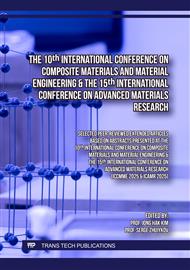p.3
p.9
p.15
p.21
p.27
p.33
p.41
p.49
Enhancing Copper-Graphene Composites for Sustainable Industry Applications
Abstract:
Graphene known as a groundbreaking nanomaterial for its outstanding mechanical strength, superior thermal conductivity, and excellent electrical properties, has gained recognition as an innovative additive for enhancing metal matrix composites. However, challenges such as agglomeration, uneven dispersion, and porosity limit its widespread application. This study aims to investigate the effects of varying graphene concentrations (0%, 0.5%, 1.0%, and 1.5%) on the microstructural, mechanical, and thermal properties of copper-graphene composites fabricated using the powder injection molding (PIM) method. The samples underwent systematic preparation and were analyzed through hardness and tensile testing, along with Scanning Electron Microscopy (SEM) for microstructural evaluation. Results revealed that incorporating 0.5% graphene significantly enhanced tensile strength (205.22 MPa), hardness (94.2 HRL), and thermal conductivity due to uniform dispersion, efficient load transfer, and reduced porosity. However, increasing graphene content to 1.0% and 1.5% led to agglomeration, increased porosity, and disrupted microstructures, resulting in reduced mechanical and thermal performance. SEM images corroborated these findings, showing a progression from smooth, well-bonded structures at 0.5% graphene to irregular, void-filled morphologies at higher concentrations, making it suitable for applications requiring efficient heat dissipation and mechanical reinforcement.
Info:
Periodical:
Pages:
9-14
Citation:
Online since:
June 2025
Price:
Сopyright:
© 2025 Trans Tech Publications Ltd. All Rights Reserved
Share:
Citation:



